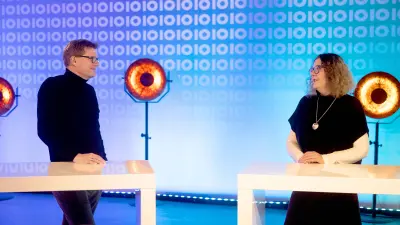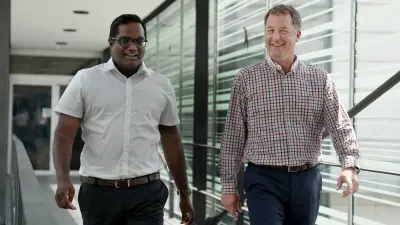Co-leadership at Bosch
Yvonne Reckling and Dr. Stefan Ferber, co-CEOs Bosch Digital

One management position, multiple management personnel — that’s the idea behind co-leadership. The success of this model depends on much more than job-sharing, say Stefan and Yvonne, co-CEOs at Bosch Digital.
The world of work is changing and companies must find ways to respond to the changes. This often requires the rethinking of traditional hierarchies and conventional management models. “Co-leadership” is one of the models that can provide answers to the demands of the modern world of work: When the management role is split, decisions and work processes are based on different perspectives, double the personal and professional experience, more knowledge, capacity and flexibility.
And for Yvonne and Stefan this style of management is not some futuristic model but their everyday reality: They share the management responsibilities for Bosch Digital, where Bosch combines its activities related to the Internet of Things. For both of them, the decisive factors for the success of co-leadership are above all a shared understanding of leadership and working together as equals.
Your company has been managed in a co-CEO configuration since it was set up in 2020. How did you learn to work in coordination with each other at the beginning?

Stefan: One day we sat down together for a long time in a creative space and put together our “Organization Manifesto”. In it, we set out our shared vision of what is important in regard to leadership and what it is to be human. Of course, we had plenty of discussions with other people that gave us the inspiration for our management model, our customer orientation and our agility. But those discussions were also about our misgivings and about what was feasible in our new form of organization. It was a big advantage starting out that both of us already had practical experience in agile management and agile organization, and so we had a very similar understanding of what management is about: We are not the kind of CEOs who just say how things should be done. Rather, we see ourselves in the role of “servant leaders” who build on the purpose of our work as well as the intrinsic motivation and abilities of our colleagues.
What is important on a day-to-day basis to ensure that shared management is successful?

Yvonne: Two different people naturally have two different personalities and management styles. What’s essential is that they share the same understanding of management. Also important is a certain sensitivity or intuition for knowing when, say, I should make a decision by myself and when I should bring the other person on board. At first our management employees didn’t know, for example, whether they should report to both of us or to just one of us — but that has now fallen into place quite well. If the co-CEOs are open, not too attached to their own opinions, and always willing to find the best common solution, then cooperation works well.
Stefan: The chemistry needs to be right. The term “co”-CEO does not exist for nothing. We are a team and we work together with appreciation for each other, by acting as equal partners and by making use of our different abilities. If we disagree on something, we talk openly about it and find a solution that is satisfactory to both of us — always with the intention of reaching the best decision for the organization and for our customers.
How do you divide up the tasks and responsibilities?
Yvonne: In my role as Chief Business Officer, I am responsible for sales, commercial processes, finance, human resources and organization, marketing and communication, project implementation and consulting. My main job is to solve problems and to remove barriers so that our team can work effectively. My colleagues come to me if something isn’t going well or is not working. But my job also includes listening to our customers so as to understand how we can help them and what they need.
Stefan: Thanks to our management tandem, I can focus more specifically on the technology aspects. In my role as Chief Technology Officer, I am responsible for product development and operation, portfolio management, the quality organization and our in-house IT, for example. But many areas are relevant to both of us, such as our strategy, our organizational development, our larger projects and the appointment of managers. By working together, we also give each other the impetus to explore new topics and trends, so that these become a part of the organization. Also important is preparing and communicating information in such a way that we can make decisions efficiently together.

Is the concept of co-CEOs a model for the future?
Yvonne: In shared management, problems and topics are automatically viewed from different angles. If you accept differing perspectives as a good thing and can respect the other person’s point of view, this can be immensely valuable. For me, therefore, the concept of co-CEOs is a superb model, but perhaps not suited to each and every team out there. First, a conventional, hierarchical organization must develop in the light of changed role models. You need a divison like Bosch Digital, which can also benefit from integrating the business aspect and the technological aspect.
Stefan: Bosch Digital (formerly Bosch.IO) was founded in 2020 from specialized Bosch IoT and Bosch Digital teams and from the former Bosch Software Innovations. We combine the AI of “artificial intelligence” with the “I” and the “T” of IoT (the “Internet of Things”). Based on our broad product portfolio, we are driving Bosch’s AIoT business and the digital transformation in the company forward. We are working with our customers to develop strategic ideas and to implement them in practice. To do this, we combine AIoT business process, technology and project competences and support our customers through all project phases — from defining the business model, through the “technical breakthrough”, all the way to implementation and operation. What is really special here, though, are our people and teams, who are learning to solve complex problems on their own on a daily basis. This requires certain technical and specialist skills, of course, but above all it’s about the ability to collaborate in and between agile teams. I am impressed by this level of creativity and performance every day.

What kind of people belong in your team?
Yvonne: Our team has a broad base of digitization and AIoT specialists and includes, for example, consultants, software developers, solution and system architects, project managers and UX designers. We support diversity and are keen to recruit employees with various backgrounds; we have an open, flat corporate culture and we promote agile working. Our recent employee survey indicated that the outstanding features of the culture at Bosch Digital are mutual respect, trust of one another and open communication. Our employees thus have the opportunity to actively create something new and to promote digital business within the context of a large group of companies.


Yvonne Reckling, co-CEO and CBO Bosch Digital
Yvonne has been co-CEO and CBO of Bosch Digital since January 2020. She started her experience at Bosch during her Economics and Business Administration studies at the University of Hohenheim as an intern, a student trainee and a graduate trainee. Her career began at Procter & Gamble, where she also served as brand manager for the Wick brand. Yvonne returned to Bosch in 2001 and was in charge of brand management for Bosch’s DIY Power Tools. She subsequently held various positions in Strategy, Business Development, Mergers & Acquisitions, Sales and Marketing. Before her position as co-CEO, Yvonne was responsible for the centralized Digital Marketing and Sales project that now forms a part of Bosch Digital and co-founded Bosch Cognitive Services — a start-up now hosted on the grow platform. Additionally, she has completed a two-year training as a systematic coach. Her time off is spent mostly with her family and in nature: “I spend most of my free time with my husband, my 17-year-old son and my two Shelties. Apart from that I’m outside a lot, especially in my garden, and I often go for walks. And I love cooking — my latest thing is Israeli cuisine.”

Dr. Stefan Ferber, co-CEO and CTO, Bosch Digital
Stefan joined Bosch in 2000 and has held various research, software development and product management positions. Fascinated by the Internet of Things and by the value that software brings to the connected world, he moved to the Bosch Software Innovations team in 2009 after getting his Ph. D. in computer science. In 2018, he became CEO of the former Bosch Software Innovations and most recently he took on the role of co-CEO and CTO at Bosch Digital from early 2020. By undertaking periodic training and occasional small software projects, Stefan strives to stay up to date in the fast-moving world of software and the Internet. Happily married, family life with his three children takes up much of his free time: “My family means a lot to me. Sadly, my sports activities, such as badminton, had to be scaled back during the coronavirus period. On the other hand, I’ve re-discovered cycling and photography in the last year. And now that our children can manage largely without us, my wife and I go walking almost every day around the Asperg near Ludwigsburg.”
Bosch Digital
Bosch Digital combines all competencies from consulting to the implementation of AIoT and digital projects. The divison focuses particularly on areas such as energy, buildings, industry, consumer goods, logistics and mobility. The Bosch Digital team consists of 800 experts in networking and digital business models. Interdisciplinary customer teams work at locations in Germany, Bulgaria, Japan, China and Singapore. Bosch Digital is characterized by its broad industry and software knowledge, which was already demonstrated in several hundred international digital and AIoT projects.


